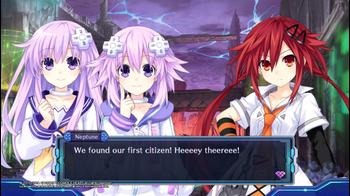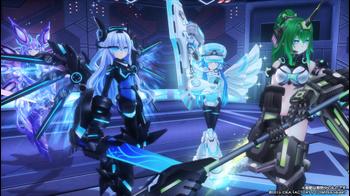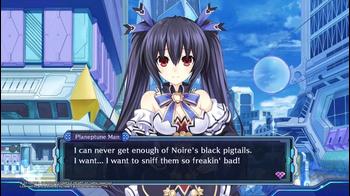
Megadimension Neptunia VII Review
Megadimension Neptunia VII represents the series’ first foray into the latest console generation. I had mentioned during my Omega Quintet review last year that Compile Heart had figured out a way to make the hardware work for them.
Whereas in the last console cycle, their games used to feature plenty of frame hitching and muddy textures, Omega Quintet saw a consistently high framerate, instant loading, and higher quality visuals. Sure, these are still budget titles, but it’s fascinating being able to see the game grow from a technical perspective.
Now it is important to keep in mind that this is a sequel. The title is read as “Megadimension Neptunia V 2”, otherwise known as Hyperdimension Neptunia Victory 2. While it takes place following the events of the original Victory, there’s honestly little in terms of cohesiveness with the earlier game's plot. Characters featured in that title such as Yellow Heart and Plutia are nowhere to be found. In fact, aside from the title, this could be considered a great entry to the series, though newcomers would benefit from playing prior entries just to get to know the characters.
The story in Megadimension is broken up into three chapters, or alternate dimensions of Gameindustri. They each have their own story to tell embedded inside an overarching narrative. In the first, Zero Dimension, Neptune and Nepgear come across a mysterious console with a swirl logo on its lid (you can imagine what it looks like in your head). After turning the console on, they are warped into a world that has been torn apart by the presence of a Dark CPU, a gigantic evil entity.
There, they meet a young CPU named Uzume who has suffered from a bout of amnesia. Worse yet, she is the last living being trying to hold the Dark CPU off from destroying the rest of the land and the friendly monsters she has aligned herself with. The second and third dimensions focus more on introducing other important characters before things come back around to Zero Dimension’s fate in the closing chapter.
During those dimensions, three characters are introduced, each representing a respective company, much like the CPUs are with consoles. K-Sha is Konami, C-Sha is Capcom, B-Sha is Bandai Namco (complete with awesome SD Gundam partner), and S-Sha is Square Enix. They are all have their interesting quirks that fit in very well with the rest of the cast.
Aside from the story hooks, there have been important changes made to the way a lot of the mechanics of the game works.
First, let’s talk about combat. The game is still as combo-heavy as it ever was, but there have been changes made to the way players can customize their attacks to make the experience more tactical. You will still level up to unlock new moves and learn new skills to use.
However, players will no longer have to micromanage combo points. Now each weapon has a set number of slots that allow one to fit unlocked moves. There are three different types of attacks to customize: Standard, Rush, and Power.
Gone is the Guard Meter and Break Attacks. Instead, certain enemies, mostly boss characters, have certain pieces of equipment, a cape for instance, that protects them. These parts can be broken to uncover weak points. Aside from being able to deal higher damage, this also rewards more XP, items, and credits, the game’s currency.
Other than that, Rush still quickly increases a character’s EXE Drive which helps utilize special skills, while Power moves dish out the most damage. Some attacks can deal elemental damage, so the way you arrange your combo can be important as it always has been.
EXE Drives are now treated more as a consumable resource and no longer carry over from one battle to the next. Whenever a CPU transforms into their HDD form, one EXE bar and some shares are spent instead of SP in previous entries. Meanwhile, shares are the lifeblood of a CPU and is important to keep an eye on for achieving the True Ending.
Early on, the game felt more punishing as party members no longer fully recovered after leveling up, forcing you to return back to town to do so. The worst part is that being KOed costs a significant amount of shares. While this doesn’t matter that much towards the end (after reading up the ending guide), it can be a real pain if you were already struggling in that department.
While this can prove challenging in the first half, the game soon becomes a cakewalk towards the end. This is especially true after reaching Level 30 where the EXE Drive bar can fill up almost per battle. There is also a hard cap on the quantity of each item you can carry, but even then it's more than enough as the game reaches its climax. Completing challenges such as being a part of the active party for X number of battles, can increase a character's stats to a large degree.
There’s also not much grinding to speak of. As long as you’re willing to defeat every enemy you come across when trying to get from point A to point B in a dungeon, things should go smoothly once you reach the boss. You are also finally able to use Heal and Revive from the menu outside of battle.
Although there is a risk of losing shares as I mentioned earlier, it doesn’t take much to regain them by doing a few guild quests. There are ways to keep the challenge going as players are able to visit the Colosseum or explore high level dungeons.
Megadimension Neptunia VII does has reformed the Scout system and has done away with Stella’s Dungeon (which kind of bums me out, but c’est la vie). Here, the player can send scouts out into different dungeons and work on a timer. This is a great way to gather new items, money, dungeons, and even other scouts, as they cost nothing to use.
They can also discover the means to unlock a Hidden Treasure inside their assigned dungeon or a new dungeon boss. After they return, you will have to manually check them at one of Gameindustri’s towns, but they automatically head back to the dungeon they were previously assigned to.
New Game Plus is where things get really exciting. First off, you will be able to completely turn off random encounters on the overworld map. Likewise, you crank them up if you’re trying to complete a objective or level up the Lily Ranks. You can also increase player movement speed and jump height.
Plus, being able to keep all of your progress and equipment means getting back to the ending only takes a couple hours. This is perfect for those looking to experience the other endings.
The audio can be a little bit of a mixed bag. There is still an uneven amount of English voice acting in the game (around 50% of what the Japanese audio has), what’s there is very good - especially Uzume. This continues to be the only series from Japan that I stick with the English voice track despite the dual audio option. It also has an amazing soundtrack mostly filled with original tracks highlighted by a few that stand up to even what Falcom can manage.
It is clear that Compile Heart has put a lot of work into creating the best Neptunia game yet. While it is still disappointing that there is such a heavy amount of dungeon recycling going on, there is plenty of new content for fans to enjoy.
The story is enjoyable, the characters are likeable, and the new mechanics that have been introduced work together to create a far more engaging experience from a gameplay perspective. While it may not go far enough to appease those on the other side, people sitting on the fence may do well to give it a purchase.



